October 14, 2019 feature
3-D integrated metasurfaces stacking up for impressive holography
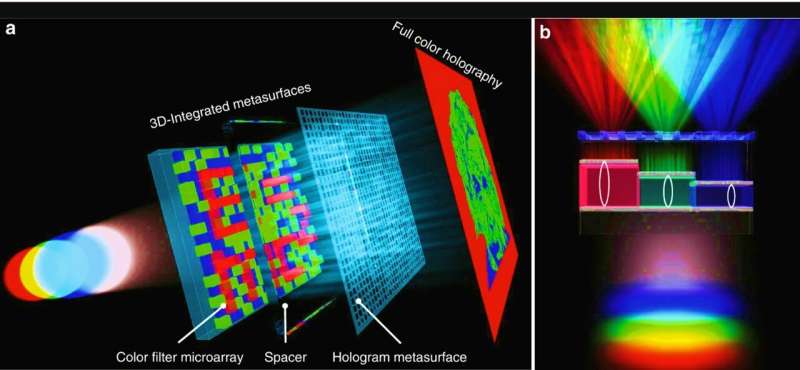
Physicists and materials scientists have developed a compact optical device containing vertically stacked metasurfaces that can generate microscopic text and full-color holograms for encrypted data storage and color displays. Yueqiang Hu and a research team in Advanced Design and Manufacturing for Vehicle Body in the College of Mechanical and Vehicle Engineering in China implemented a 3-D integrated metasurface device to facilitate miniaturization of the optical device. Using metasurfaces with ultrathin and compact characteristics, the research team designed optical elements by engineering the wavefront of light at the subwavelength scale. The metasurfaces possessed great potential to integrate multiple functions into the miniaturized optoelectronic systems. The work is now published on Light: Science & Applications.
Since existing research on multiplexing in the 2-D plane remains to fully incorporate capabilities of metasurfaces for multi-tasking, in the present work, the team demonstrated a 3-D integrated metasurface device. For this, they stacked a hologram metasurface on a monolithic Fabry-Pérot (FP) cavity-based color filter microarray to achieve simultaneous cross-talk, polarization-independent and highly efficient full-color holography and microprint functions. The dual function of the device outlined a new scheme for data recording, security, encryption color displays and information processing applications. The work on 3-D integration can be extended to establish flat multi-tasking optical systems that include a variety of functional metasurface layers.
Metasurfaces open a new direction in optoelectronics, allowing researchers to design optical elements by shaping the wavefront of electromagnetic waves relative to size, shape and arrangement of structures at the subwavelength. Physicists have engineered a variety of metasurface-based devices including lenses, polarization converters, holograms and orbital angular momentum generators (OAM). They have demonstrated the performance of metasurface-based devices to even surpass conventional refractive elements to construct compact optical devices with multiple functions. Such devices are, however, withheld by shortcomings due to a reduced efficiency of plasmonic nanostructures, polarization requirements, large crosstalk and complexity of the readout for multiwavelength and broadband optical devices. Research teams can therefore stack 3-D metasurface-based devices with different functions in the vertical direction to combine the advantages of each device. While simultaneously reducing the difficulties of integration and increasing the design freedom to generate new features and improve optical device inclusion to generate compact, multifunctional devices.
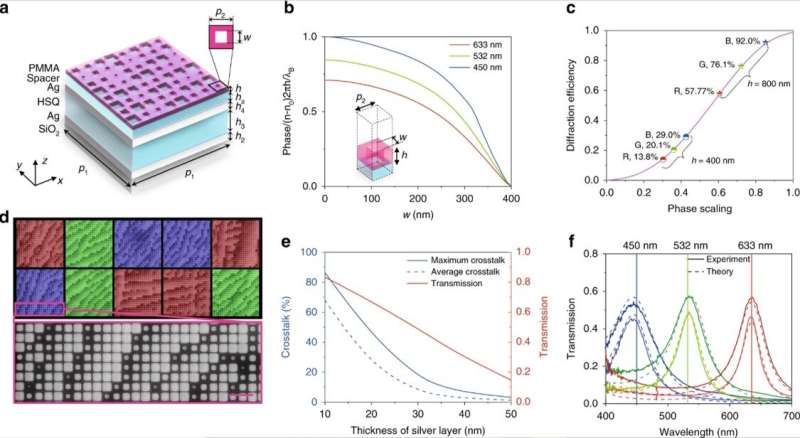
In the present work, Hu et al. combined 3-D metasurfaces to form full-color holography by stacking a monolithic color filter micro-array and hologram metasurface. The device resolved the bottleneck problems of full-color holography such as large crosstalk and the small field-of-view (FOV). They obtained a color microprint image by illuminating the device with white light. The researchers obtained a full color hologram image by projecting into the far-field under red (R), green (G) and blue (B) laser illumination (RBG), while mixing with three independent grayscale hologram images. The new 3-D integrated device showed low crosstalk, high efficiency and a simple fabrication process. Using the thin and flat metasurfaces, the team built an integrated device that surpassed traditional optical devices. The work represents substantial progress in exploring 3-D integrated metasurfaces such as polarizers and meta-lenses to form multifunctional, ultrathin optical systems.
The research team developed microscale, stepwise structures containing an array of metal/dielectric/metal Fabry-Pérot (MDMFP) cavity resonators to act as color filters with varied dielectric thicknesses. They proved the MDMFP color filters to have high transmission efficiency, wide color gamut (range of colors) and narrow spectral linewidths compared to plasmonic color filters. They composed the hologram metasurface of isotropic dielectric nanostructures to manipulate the propagation phase of light at the subwavelength scale and generate high-quality, far-field hologram images.
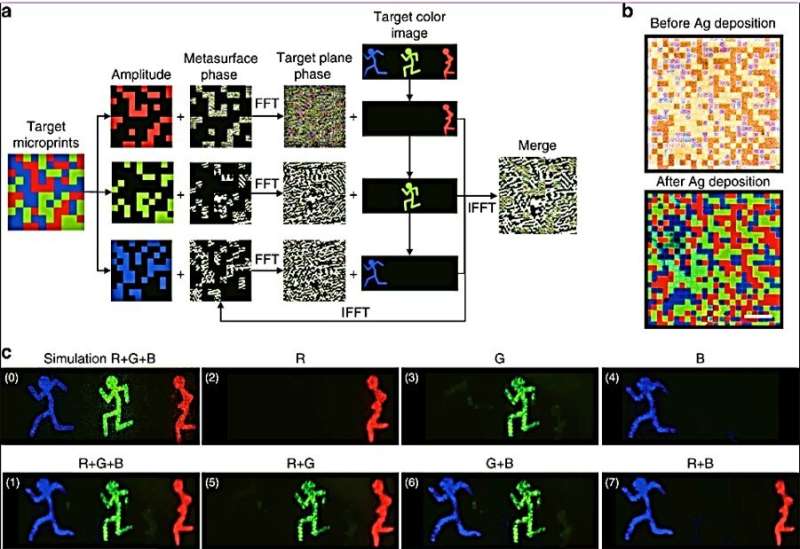
By illuminating the device with RGB lasers, Hu et al. generated three independent, far-field monochromatic grayscale hologram images to carefully mix the three channels and achieve a full-color hologram image. They designed the metasurface to form a projection at the desired wavelength and encoded holographic information on specifically arranged color filters, including color microprint information. The experimental setup had several advantages and the device could be easily manufactured using common electron-beam lithography (EBL) and metal evaporation processes.
During the design and fabrication process of the 3-D devices, Hu et al. engineered dielectric nanoholes on to hologram metasurfaces. By altering the size of the nanoholes, the scientists obtained different phase responses to shape the desired wavefront for the hologram. The phase scaling merely reduced the efficiency of the hologram without affecting its information. The research team used a (poly) methyl methacrylate (PMMA) material with a height of 400 nm, although higher structures and materials with a larger refractive index can be applied to achieve higher efficiency of diffraction.
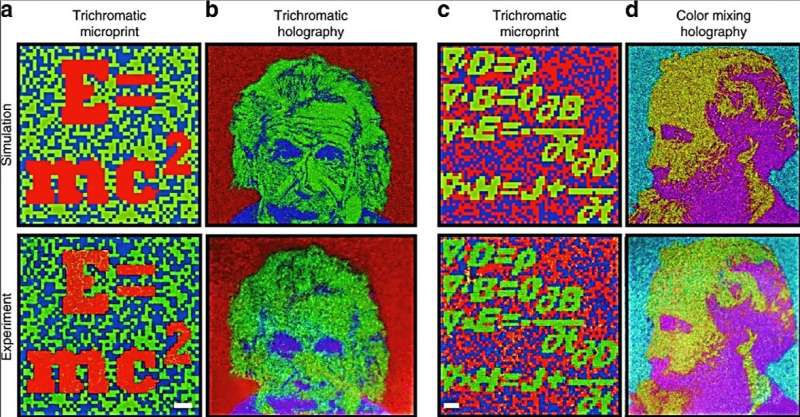
For the basic configuration of the color filter, Hu et al. used a silver (Ag)/hydrogen silsequioxane (HSQ)/Ag resonance cavity structure on a quartz substrate, where the silver layers acted as semi-reflective films. The research team calculated the influence of the silver film thickness on the RGB wavelengths used in the experiments to show suppressed crosstalk due to increased silver film thickness—but with reduced transmission efficiency. When the silver film was only thicker than 30 nm, the crosstalk reduction was negligible. Hu et al. obtained a false-color scanning electron microscopy (SEM) image of the fabricated 3-D integrated metasurface device to verify its structure. They compared the experimental transmission spectra for the RGB channel with the theoretical calculation to show the results agreed well.
To achieve dual functions of microprint and holography, the scientists developed a modified Gerchberg-Saxton (GS) algorithm to encode two types of independent information into a microprint and a hologram. The team matched each pixel of the color image to the closest color in the palette, to form multicolored components. They selected suitable color filters for the RGB channels with small crosstalk between each other to ultimately achieve separate R, G and B, grayscale hologram images. They then merged the three phase distribution components to form the final phase of the hologram. To verify the concept, they constructed a 3-D integrated metasurface with a trichromatic color microprint of a running man holography. Hu et al. compared the simulation and experimental result to show the device recovered the designed image information well. The concept of a microprint and wavelength multiplexed hologram can be used for encryption to enhance information security. Scientists can use different combinations of laser channels to create a full-color image by balancing the input powers of RGB.
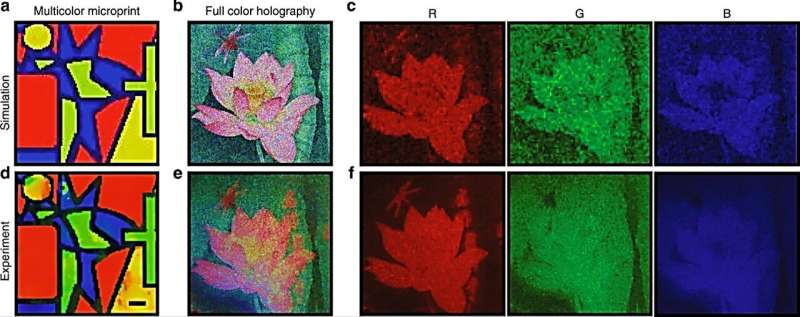
Based on the dual function of the microprint and the color meta-hologram, the scientists developed two encryption devices. They compared the simulated and experimental results of the trichromatic microprints of the first device, which included the mass-energy equation proposed by Albert Einstein. The 50 x 50 pixels microprint included the main information in red and the background in green and blue. The research team then projected a color meta-hologram designed in parallel to the microprint and captured the hologram image using RGB laser illumination. For the hologram image, they used a trichromatic portrait of Albert Einstein, which combined the RGB binary images. Similarly, Hu et al. developed a microprint of the Maxwell equations and a holographic portrait of James Clerk Maxwell.
The research team used diverse MDMFP cavities with various dielectric thicknesses within the integrated metasurface device to realize a full-color microprint of an arbitrary image. Additionally, they obtained a full-color hologram by combining the grayscale monochrome images of the RGB channels. For instance, when they next encoded the metasurface with a full-color image containing grayscale information of a "Chinese painting of a lotus," they could demonstrate full-color holography of a pink lotus with a yellow flower core, dark green leaf, dark water and red dragonfly. The team could adjust the power of the three lasers in the experiment to achieve the closest result to the original image. Owing to the small crosstalk of the different channels, the scientists were able to recover most details of the painting by combining the three monochrome components.
In this way, Yueqiang Hu and colleagues proposed and demonstrated a 3-D integrated metasurface concept to realize full-color holography by vertically stacking a color filter microarray and a nanostructured hologram metasurface. Prior to integration, the device showed dual functions for encryption and storage. The researchers obtained miniaturized color microprints under white-light illumination and full-color holograms with RGB laser illumination, with low crosstalk and high efficiency compared to existing techniques to achieve full-color holography. The work provides excellent examples of using metasurfaces in multifunctional on-chip optoelectronic devices to miniaturize optical systems.
More information: Nanfang Yu et al. Science Yueqiang Hu et al. 3-D-Integrated metasurfaces for full-colour holography, Light: Science & Applications (2019). DOI: 10.1038/s41377-019-0198-y
Wei Ting Chen et al. A broadband achromatic metalens for focusing and imaging in the visible, Nature Nanotechnology (2017). DOI: 10.1038/s41565-017-0034-6
N. Yu et al. Light Propagation with Phase Discontinuities: Generalized Laws of Reflection and Refraction, Science (2011). DOI: 10.1126/science.1210713
Journal information: Light: Science & Applications , Science , Nature Nanotechnology
© 2019 Science X Network



















